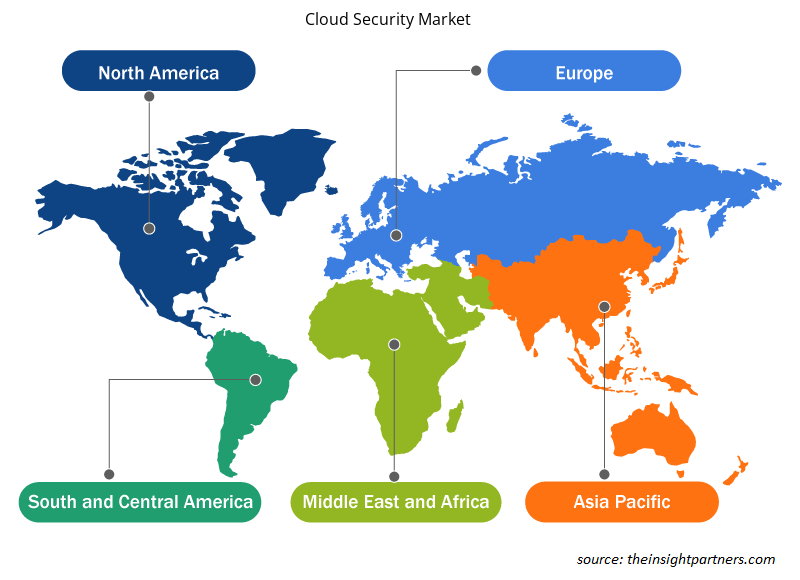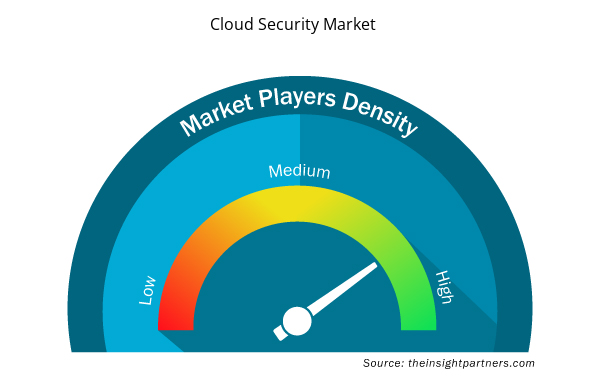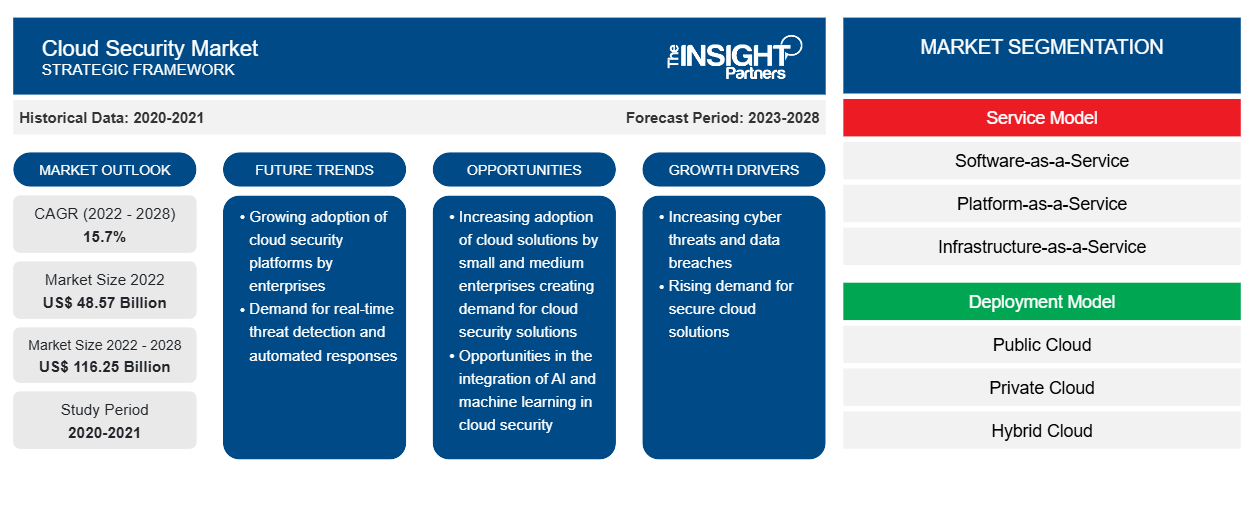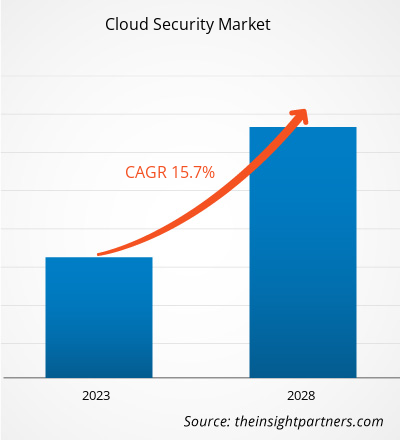Der Markt für Cloud-Sicherheit soll von 48,57 Milliarden US-Dollar im Jahr 2022 auf 116,25 Milliarden US-Dollar im Jahr 2028 wachsen; von 2022 bis 2028 wird mit einer durchschnittlichen jährlichen Wachstumsrate von 15,7 % gerechnet.
Aufgrund der steigenden Zahl von Online-Sicherheitsverletzungen und technologischen Angriffen ist die Aufrechterhaltung der Sicherheit in Unternehmen von entscheidender Bedeutung geworden. Cloud-Sicherheit bietet zahlreiche Schutzebenen innerhalb der Netzwerkinfrastruktur vor unbefugtem Zugriff, Datenverletzungen und Distributed-Denial-of-Service-Angriffen (DDoS). Im Jahr 2022 führte Flexera, ein amerikanisches Computersoftwareunternehmen, eine Studie durch und prognostizierte, dass fast 57 % der Unternehmen ihre Arbeitslasten in die Cloud verlagern. Außerdem haben fast 6 von 10 Unternehmen ihre Arbeit in die Cloud verlagert. Daher treibt die zunehmende Zahl von Unternehmen, die eine Cloud-basierte Infrastruktur nutzen, die Einführung von Cloud-Sicherheitslösungen voran.
Zu den großen, bekannten und finanzkräftigen Unternehmen in der globalen Cloud-Sicherheitsbranche gehören Amazon Web Services, Inc., Microsoft, IBM Corporation, Oracle und Google, Inc. Aus diesem Grund ist die Verhandlungsmacht der Käufer auf dem Cloud-Sicherheitsmarkt recht hoch. Darüber hinaus wird aufgrund des technologischen Fortschritts in der Cloud-Sicherheit und der steigenden Zahl verwalteter Containerdienste davon ausgegangen, dass die Verhandlungsmacht der Käufer zwischen 2019 und 2028 hoch bleiben wird. Die großen Unternehmen auf dem Cloud-Sicherheitsmarkt verfolgen unterschiedliche Strategien bei der Planung von Lösungs- und Servicemodellen für unterschiedliche Branchen. Kontinuierliche Fortschritte im Technologiesektor werden voraussichtlich Druck auf Cloud-Sicherheitsanbieter ausüben, sich an die Veränderungen anzupassen, um ihre Marktposition zu behaupten.
Passen Sie diesen Bericht Ihren Anforderungen an
Sie erhalten kostenlos individuelle Anpassungen an jedem Bericht, einschließlich Teilen dieses Berichts oder einer Analyse auf Länderebene, eines Excel-Datenpakets sowie tolle Angebote und Rabatte für Start-ups und Universitäten.
- Holen Sie sich die wichtigsten Markttrends aus diesem Bericht.Dieses KOSTENLOSE Beispiel umfasst eine Datenanalyse von Markttrends bis hin zu Schätzungen und Prognosen.
Auswirkungen der COVID-19-Pandemie auf den Marktanteil im Bereich Cloud-Sicherheit
Der COVID-19-Ausbruch hatte auf seinem Höhepunkt im Jahr 2020 dramatische Auswirkungen auf die Weltwirtschaft und behinderte die Geschäftsaktivitäten in zahlreichen Branchen weltweit. Aufgrund von Reisebeschränkungen und Geschäftsschließungen kam es auch zu einer unbestimmten Unterbrechung des Betriebs mehrerer Firmen, Kunden und Partner. Aufgrund enormer Investitionen in die digitale Transformation verzeichneten Remote- und Hybrid-Arbeitsmodelle einen rasanten Anstieg . Darüber hinaus kam es zu einer massiven Einführung von Cloud-Sicherheit, vorangetrieben durch die Pandemie, den Ausbau von Rechenzentren, staatliche Ausgaben für riesige Smart Cities und Projekte der öffentlichen Verwaltung zur Unterstützung der Einführung neuer Technologien in Unternehmen. Die Softwarebranche blieb von der Pandemie unberührt, da mehrere Unternehmen ihren Mitarbeitern erlaubten, von zu Hause aus zu arbeiten. Außerdem setzten Unternehmen zunehmend auf Cloud-Sicherheitslösungen und -Dienste, um den Personalbedarf für die Datenpflege zu reduzieren. Auf diese Weise konnten sie ihre Belegschaft vor möglichen Infektionen schützen und gleichzeitig sicherstellen, dass die Produktion nicht beeinträchtigt wurde.
Markteinblick – Cloud-Sicherheitsmarkt
Steigende Nutzung von Cloud-basierten Lösungen und Managed Security Services treibt Wachstum im Cloud-Sicherheitsmarkt voran
Die Nachfrage nach Cloud-basierten Diensten ist während der COVID-19-Pandemie aufgrund der weit verbreiteten Einführung des Homeoffice-Modells deutlich gestiegen. Microsoft verzeichnete im Jahr 2021 einen Nachfrageanstieg von 775 % bei seiner Cloud-Service-Plattform. Kleine und mittlere Unternehmen (KMU) nutzen verwaltete Sicherheitsdienste, da ihnen das interne Fachwissen fehlt, um Cloud-Dienste effektiv zu verwalten. Laut OTAVA können sie mit diesen Strategien die Vorteile einer öffentlichen Cloud mit der Sicherheit einer privaten Cloud-Umgebung vor Ort kombinieren. Laut Flexeras State of the Cloud Report 2020 nutzen Unternehmen Cloud-Dienste, wobei 93 % von ihnen eine Multi-Cloud-Strategie verwenden und 87 % eine Hybrid-Cloud-Strategie bevorzugen. Es besteht eine bemerkenswerte Nachfrage nach Cloud-Sicherheitsdiensten, die von bedeutenden Cybersicherheitsanbietern wie Google, Microsoft und Amazon angeboten werden. Einige potenzielle Vorteile der Integration von Cloud Computing in die Verfahren und Abläufe von KMU sind vereinfachter Zugriff, schnelle Implementierung, geringer IT-Infrastrukturbedarf und niedrige Installationskosten.
Einblicke auf Basis von Bereitstellungsmodellen
Basierend auf dem Bereitstellungsmodell ist der Cloud-Sicherheitsmarkt in öffentliche, private und hybride Clouds segmentiert. Im Jahr 2022 hatte das Segment der öffentlichen Cloud den größten Marktanteil im Bereich Cloud-Sicherheit. Unternehmen setzen in großem Umfang öffentliche Clouds über Drittanbieter von Cloud-Diensten (CSPs) ein, um Anwendungen und Daten innerhalb ihrer Infrastruktur zu verwalten. Darüber hinaus bieten wichtige Akteure auf dem Markt weiterhin integrierte Sicherheitstools an, die zum Schutz geschäftskritischer Daten beitragen. Die breite Öffentlichkeit, Einzelpersonen und Unternehmen fühlen sich weitgehend von öffentlichen Cloud-Infrastrukturen angezogen, da sie Service-Skalierbarkeit bieten und den Verwaltungsaufwand für das interne IT-Personal verringern. Diese Faktoren treiben das Wachstum des Cloud-Sicherheitsmarktes im Segment der öffentlichen Clouds voran.
Die auf dem Cloud-Sicherheitsmarkt tätigen Akteure konzentrieren sich hauptsächlich auf die Entwicklung fortschrittlicher und effizienter Produkte.
- Im August 2022 führte VMware Inc. bedeutende Verbesserungen seiner einzigartigen lateralen Sicherheitsfunktionen ein, um Kunden dabei zu helfen, Sicherheit für moderne und traditionelle Anwendungen für Multi-Cloud-Umgebungen zu erreichen und so das Wachstum des Cloud-Sicherheitsmarktes anzukurbeln.
- Im Juni 2022 erweiterte Palo Alto Networks die Cloud-native Anwendungsschutzplattform um Funktionen wie kontextbezogene Softwarezusammensetzungsanalyse und Software-Stückliste.
Regionale Einblicke in den Cloud-Sicherheitsmarkt
Die regionalen Trends und Faktoren, die den Cloud-Sicherheitsmarkt im Prognosezeitraum beeinflussen, wurden von den Analysten von Insight Partners ausführlich erläutert. In diesem Abschnitt werden auch die Marktsegmente und die Geografie des Cloud-Sicherheitsmarkts in Nordamerika, Europa, im asiatisch-pazifischen Raum, im Nahen Osten und Afrika sowie in Süd- und Mittelamerika erörtert.

- Erhalten Sie regionale Daten zum Cloud-Sicherheitsmarkt
Umfang des Cloud-Sicherheitsmarktberichts
| Berichtsattribut | Details |
|---|---|
| Marktgröße im Jahr 2022 | 48,57 Milliarden US-Dollar |
| Marktgröße bis 2028 | 116,25 Milliarden US-Dollar |
| Globale CAGR (2022 - 2028) | 15,7 % |
| Historische Daten | 2020-2021 |
| Prognosezeitraum | 2023–2028 |
| Abgedeckte Segmente | Nach Servicemodell
|
| Abgedeckte Regionen und Länder | Nordamerika
|
| Marktführer und wichtige Unternehmensprofile |
|
Marktteilnehmerdichte: Der Einfluss auf die Geschäftsdynamik
Der Cloud-Sicherheitsmarkt wächst rasant, angetrieben durch die steigende Nachfrage der Endnutzer aufgrund von Faktoren wie sich entwickelnden Verbraucherpräferenzen, technologischen Fortschritten und einem größeren Bewusstsein für die Vorteile des Produkts. Mit steigender Nachfrage erweitern Unternehmen ihr Angebot, entwickeln Innovationen, um die Bedürfnisse der Verbraucher zu erfüllen, und nutzen neue Trends, was das Marktwachstum weiter ankurbelt.
Die Marktteilnehmerdichte bezieht sich auf die Verteilung der Firmen oder Unternehmen, die in einem bestimmten Markt oder einer bestimmten Branche tätig sind. Sie gibt an, wie viele Wettbewerber (Marktteilnehmer) in einem bestimmten Marktraum im Verhältnis zu seiner Größe oder seinem gesamten Marktwert präsent sind.
Die wichtigsten auf dem Cloud-Sicherheitsmarkt tätigen Unternehmen sind:
- Amazon Web Services, Inc.
- Microsoft
- Google LLC
- Orakel
- IBM Corporation
Haftungsausschluss : Die oben aufgeführten Unternehmen sind nicht in einer bestimmten Reihenfolge aufgeführt.

- Überblick über die wichtigsten Akteure auf dem Cloud-Sicherheitsmarkt
Der Cloud-Sicherheitsmarkt ist in fünf große Regionen unterteilt: Nordamerika, Europa, Asien-Pazifik (APAC), Naher Osten und Afrika sowie Südamerika. Im Jahr 2022 war Nordamerika mit einem beträchtlichen Umsatzanteil Marktführer, gefolgt von Europa. Darüber hinaus wird erwartet, dass der Asien-Pazifik-Raum von 2022 bis 2028 die höchste durchschnittliche jährliche Wachstumsrate (CAGR) auf dem Markt verzeichnet.
Amazon Web Services, Inc.; Microsoft; IBM Corporation; Oracle; Trend Micro Incorporated; VMware, Inc.; Palo Alto Networks, Inc.; Cisco Systems, Inc.; Check Point Software Technologies Ltd.; und Google, Inc. gehören zu den wichtigsten Akteuren auf dem Cloud-Sicherheitsmarkt. Der Marktbericht liefert detaillierte Markteinblicke, die den wichtigsten Akteuren dabei helfen, das Wachstum in den kommenden Jahren strategisch zu planen.
- Historische Analyse (2 Jahre), Basisjahr, Prognose (7 Jahre) mit CAGR
- PEST- und SWOT-Analyse
- Marktgröße Wert/Volumen – Global, Regional, Land
- Branche und Wettbewerbsumfeld
- Excel-Datensatz



Report Coverage
Revenue forecast, Company Analysis, Industry landscape, Growth factors, and Trends

Segment Covered
This text is related
to segments covered.

Regional Scope
North America, Europe, Asia Pacific, Middle East & Africa, South & Central America

Country Scope
This text is related
to country scope.
Häufig gestellte Fragen
Amazon Web Services, Inc.; Microsoft; IBM Corporation; Oracle; Trend Micro Incorporated; VMware, Inc.; Palo Alto Networks, Inc.; Cisco Systems, Inc.; Check Point Software Technologies Ltd.; and Google, Inc. are the leading companies in the cloud security market.
Cloud-native applications, which are created specifically to operate on the cloud, are gaining prevalence with the growing use of cloud platforms; therefore—surge in technological advancements in cloud security is one of the major trends in the cloud security market.
North America dominated the cloud security market in 2021. With higher penetration of large and mid-sized companies, there is a growing frequency of cyber-attacks and the increasing number of hosted servers. Moreover, growing number of cybercrime and the production of new cyberattacks, as well as surge in usage of cloud-based solutions are all becoming major factor propelling the market growth in the region.
With growing adoption of artificial intelligence & machine learning, cybersecurity teams are expected to gain valuable tools for averting security breaches and focusing more on innovation to achieve their long-term business goals. Also, surge in number of governments initiatives & investments in cloud technology are anticipated to create growth opportunity for the market players in the coming years.
Due to rising number of cyberattacks, businesses are implementing cutting-edge cybersecurity tools to identify risks and reduce costs associated with data breaches. Moreover, surge in usage of cloud-based solutions & managed security services and increasing managed container services are propelling the growth of the cloud security market.
Trends and growth analysis reports related to Technology, Media and Telecommunications : READ MORE..
The List of Companies - Cloud Security Market
- Amazon Web Services, Inc.
- Microsoft
- Google LLC
- Oracle
- IBM Corporation
- Cisco System, Inc.
- Trend Micro Incorporated
- Palo Alto Networks, Inc.
- Checkpoint Software Technologies
- VMware, Inc.
The Insight Partners performs research in 4 major stages: Data Collection & Secondary Research, Primary Research, Data Analysis and Data Triangulation & Final Review.
- Data Collection and Secondary Research:
As a market research and consulting firm operating from a decade, we have published and advised several client across the globe. First step for any study will start with an assessment of currently available data and insights from existing reports. Further, historical and current market information is collected from Investor Presentations, Annual Reports, SEC Filings, etc., and other information related to company’s performance and market positioning are gathered from Paid Databases (Factiva, Hoovers, and Reuters) and various other publications available in public domain.
Several associations trade associates, technical forums, institutes, societies and organization are accessed to gain technical as well as market related insights through their publications such as research papers, blogs and press releases related to the studies are referred to get cues about the market. Further, white papers, journals, magazines, and other news articles published in last 3 years are scrutinized and analyzed to understand the current market trends.
- Primary Research:
The primarily interview analysis comprise of data obtained from industry participants interview and answers to survey questions gathered by in-house primary team.
For primary research, interviews are conducted with industry experts/CEOs/Marketing Managers/VPs/Subject Matter Experts from both demand and supply side to get a 360-degree view of the market. The primary team conducts several interviews based on the complexity of the markets to understand the various market trends and dynamics which makes research more credible and precise.
A typical research interview fulfils the following functions:
- Provides first-hand information on the market size, market trends, growth trends, competitive landscape, and outlook
- Validates and strengthens in-house secondary research findings
- Develops the analysis team’s expertise and market understanding
Primary research involves email interactions and telephone interviews for each market, category, segment, and sub-segment across geographies. The participants who typically take part in such a process include, but are not limited to:
- Industry participants: VPs, business development managers, market intelligence managers and national sales managers
- Outside experts: Valuation experts, research analysts and key opinion leaders specializing in the electronics and semiconductor industry.
Below is the breakup of our primary respondents by company, designation, and region:

Once we receive the confirmation from primary research sources or primary respondents, we finalize the base year market estimation and forecast the data as per the macroeconomic and microeconomic factors assessed during data collection.
- Data Analysis:
Once data is validated through both secondary as well as primary respondents, we finalize the market estimations by hypothesis formulation and factor analysis at regional and country level.
- Macro-Economic Factor Analysis:
We analyse macroeconomic indicators such the gross domestic product (GDP), increase in the demand for goods and services across industries, technological advancement, regional economic growth, governmental policies, the influence of COVID-19, PEST analysis, and other aspects. This analysis aids in setting benchmarks for various nations/regions and approximating market splits. Additionally, the general trend of the aforementioned components aid in determining the market's development possibilities.
- Country Level Data:
Various factors that are especially aligned to the country are taken into account to determine the market size for a certain area and country, including the presence of vendors, such as headquarters and offices, the country's GDP, demand patterns, and industry growth. To comprehend the market dynamics for the nation, a number of growth variables, inhibitors, application areas, and current market trends are researched. The aforementioned elements aid in determining the country's overall market's growth potential.
- Company Profile:
The “Table of Contents” is formulated by listing and analyzing more than 25 - 30 companies operating in the market ecosystem across geographies. However, we profile only 10 companies as a standard practice in our syndicate reports. These 10 companies comprise leading, emerging, and regional players. Nonetheless, our analysis is not restricted to the 10 listed companies, we also analyze other companies present in the market to develop a holistic view and understand the prevailing trends. The “Company Profiles” section in the report covers key facts, business description, products & services, financial information, SWOT analysis, and key developments. The financial information presented is extracted from the annual reports and official documents of the publicly listed companies. Upon collecting the information for the sections of respective companies, we verify them via various primary sources and then compile the data in respective company profiles. The company level information helps us in deriving the base number as well as in forecasting the market size.
- Developing Base Number:
Aggregation of sales statistics (2020-2022) and macro-economic factor, and other secondary and primary research insights are utilized to arrive at base number and related market shares for 2022. The data gaps are identified in this step and relevant market data is analyzed, collected from paid primary interviews or databases. On finalizing the base year market size, forecasts are developed on the basis of macro-economic, industry and market growth factors and company level analysis.
- Data Triangulation and Final Review:
The market findings and base year market size calculations are validated from supply as well as demand side. Demand side validations are based on macro-economic factor analysis and benchmarks for respective regions and countries. In case of supply side validations, revenues of major companies are estimated (in case not available) based on industry benchmark, approximate number of employees, product portfolio, and primary interviews revenues are gathered. Further revenue from target product/service segment is assessed to avoid overshooting of market statistics. In case of heavy deviations between supply and demand side values, all thes steps are repeated to achieve synchronization.
We follow an iterative model, wherein we share our research findings with Subject Matter Experts (SME’s) and Key Opinion Leaders (KOLs) until consensus view of the market is not formulated – this model negates any drastic deviation in the opinions of experts. Only validated and universally acceptable research findings are quoted in our reports.
We have important check points that we use to validate our research findings – which we call – data triangulation, where we validate the information, we generate from secondary sources with primary interviews and then we re-validate with our internal data bases and Subject matter experts. This comprehensive model enables us to deliver high quality, reliable data in shortest possible time.


 Holen Sie sich ein kostenloses Muster für diesen Bericht
Holen Sie sich ein kostenloses Muster für diesen Bericht